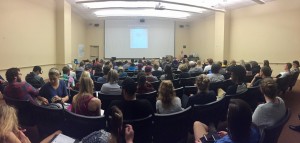Around 200 WCU students and faculty attended when they were discovering the history and culture of the Middle East through an unusual art form – mosaics.
Distinguished art historian and archaeologist, Dr. Karen Britt, held a lecture for all interested students and faculty in Bardo Arts Center Tuesday evening.
As part of a guest speaker series organized by WCU’s art and design department, Britt presented her lecture titled, “Mosaics in the Middle East” based off her personal work with mosaics across the globe.

The seats of Bardo 130 filled with students for the guest lecture of art historian, Dr. Karen Britt. Photo by: Ashley Kairis
Mosaics are commonly defined as a picture or other design constructed from smaller pieces.
In Britt’s case, she uncovers, interprets and documents mosaics that have taken her to sites in Italy, Greece and the Middle East. Her focus is on the early Byzantine Empire and the political and religious history that exists through artistic traditions. Her team’s findings will be featured in an upcoming issue of National Geographic.
National Geographic has exclusive rights to these mosaics, limiting the amount of photos that could be taken at the lecture.
“Having something appear before my eyes that hasn’t been seen for a long time is really exhilarating. It’s why all archaeologists do what we do, because there’s a thrill of discovery,” said Britt.
Nearly 200 students and faculty sat hushed and at attention, taking in not just the photographed mosaics, but also the history and cultural significance behind them.
“Britt did a fantastic job of showing how these traditions and techniques are passed down from one civilization or culture to another and how they influence subsequent artists and architects,” said Seth McCormick, associate professor of art history.
The mosaics discussed have mostly been found in churches and synagogues, dating between the fifth and eighth centuries. Many of them illustrate scenes from the Bible and have layers of interpretations.
The lecture showed how uncovered art, such as mosaics, can evoke emotion, spark intrigue and serve as an outlet for conversation about the history of the Middle East.
“This whole presentation was good because she’s not only studying it, she’s also been to all these places so she knows what she’s talking about through experience,” said junior art major, Hannah Faub.
As the lecture came to a close, Britt explained how looking at these preserved mosaics gives a factual, accurate basis to discuss differences and interactions between Muslim, Christian, and Jewish cultures both past and present.
“What I hope that people take from the lecture is that, in a world in which we focus so much on what makes us different from each other, particularly in the Middle East, that there is early evidence for engagement and contact between Jewish, Christian and Muslim cultures,” said Britt.
Taking the knowledge from this lecture, students can apply the same type of critical analysis and evaluation no matter what discipline they may fall into.
Britt will return to WCU as an adjunct instructor of art history in the spring 2017 semester.


